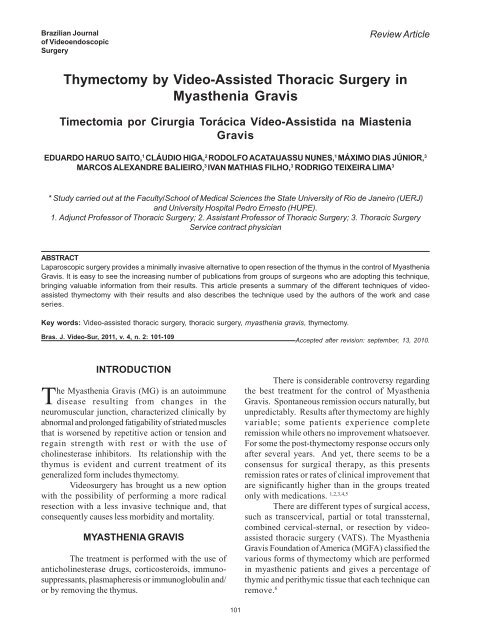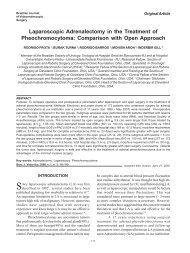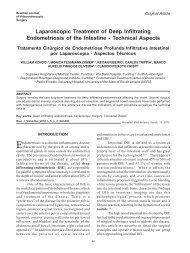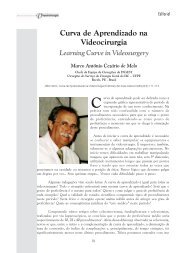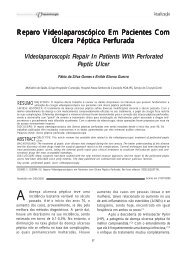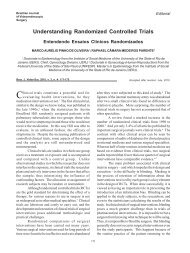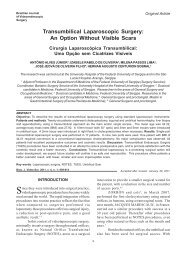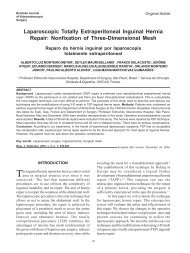Thymectomy by Video-Assisted Thoracic Surgery in ... - Sobracil
Thymectomy by Video-Assisted Thoracic Surgery in ... - Sobracil
Thymectomy by Video-Assisted Thoracic Surgery in ... - Sobracil
Create successful ePaper yourself
Turn your PDF publications into a flip-book with our unique Google optimized e-Paper software.
Vol. Brazilian 4, Nº 2Journal<br />
of <strong>Video</strong>endoscopic<br />
<strong>Surgery</strong><br />
Review Article<br />
<strong>Thymectomy</strong> <strong>by</strong> <strong>Video</strong>-<strong>Assisted</strong> <strong>Thoracic</strong> <strong>Surgery</strong> <strong>in</strong> Myasthenia Gravis 101<br />
<strong>Thymectomy</strong> <strong>by</strong> <strong>Video</strong>-<strong>Assisted</strong> <strong>Thoracic</strong> <strong>Surgery</strong> <strong>in</strong><br />
Myasthenia Gravis<br />
Timectomia por Cirurgia Torácica Vídeo-Assistida na Miastenia<br />
Gravis<br />
EDUARDO HARUO SAITO, 1 CLÁUDIO HIGA, 2 RODOLFO ACATAUASSU NUNES, 1 MÁXIMO DIAS JÚNIOR, 3<br />
MARCOS ALEXANDRE BALIEIRO, 3 IVAN MATHIAS FILHO, 3 RODRIGO TEIXEIRA LIMA 3<br />
* Study carried out at the Faculty/School of Medical Sciences the State University of Rio de Janeiro (UERJ)<br />
and University Hospital Pedro Ernesto (HUPE).<br />
1. Adjunct Professor of <strong>Thoracic</strong> <strong>Surgery</strong>; 2. Assistant Professor of <strong>Thoracic</strong> <strong>Surgery</strong>; 3. <strong>Thoracic</strong> <strong>Surgery</strong><br />
Service contract physician<br />
ABSTRACT<br />
Laparoscopic surgery provides a m<strong>in</strong>imally <strong>in</strong>vasive alternative to open resection of the thymus <strong>in</strong> the control of Myasthenia<br />
Gravis. It is easy to see the <strong>in</strong>creas<strong>in</strong>g number of publications from groups of surgeons who are adopt<strong>in</strong>g this technique,<br />
br<strong>in</strong>g<strong>in</strong>g valuable <strong>in</strong>formation from their results. This article presents a summary of the different techniques of videoassisted<br />
thymectomy with their results and also describes the technique used <strong>by</strong> the authors of the work and case<br />
series.<br />
Key words: <strong>Video</strong>-assisted thoracic surgery, thoracic surgery, myasthenia gravis, thymectomy.<br />
Bras. J. <strong>Video</strong>-Sur, 2011, v. 4, n. 2: 101-109<br />
Accepted after revision: september, 13, 2010.<br />
INTRODUCTION<br />
The Myasthenia Gravis (MG) is an autoimmune<br />
disease result<strong>in</strong>g from changes <strong>in</strong> the<br />
neuromuscular junction, characterized cl<strong>in</strong>ically <strong>by</strong><br />
abnormal and prolonged fatigability of striated muscles<br />
that is worsened <strong>by</strong> repetitive action or tension and<br />
rega<strong>in</strong> strength with rest or with the use of<br />
chol<strong>in</strong>esterase <strong>in</strong>hibitors. Its relationship with the<br />
thymus is evident and current treatment of its<br />
generalized form <strong>in</strong>cludes thymectomy.<br />
<strong>Video</strong>surgery has brought us a new option<br />
with the possibility of perform<strong>in</strong>g a more radical<br />
resection with a less <strong>in</strong>vasive technique and, that<br />
consequently causes less morbidity and mortality.<br />
MYASTHENIA GRAVIS<br />
The treatment is performed with the use of<br />
antichol<strong>in</strong>esterase drugs, corticosteroids, immunosuppressants,<br />
plasmapheresis or immunoglobul<strong>in</strong> and/<br />
or <strong>by</strong> remov<strong>in</strong>g the thymus.<br />
There is considerable controversy regard<strong>in</strong>g<br />
the best treatment for the control of Myasthenia<br />
Gravis. Spontaneous remission occurs naturally, but<br />
unpredictably. Results after thymectomy are highly<br />
variable; some patients experience complete<br />
remission while others no improvement whatsoever.<br />
For some the post-thymectomy response occurs only<br />
after several years. And yet, there seems to be a<br />
consensus for surgical therapy, as this presents<br />
remission rates or rates of cl<strong>in</strong>ical improvement that<br />
are significantly higher than <strong>in</strong> the groups treated<br />
only with medications. 1,2,3,4,5<br />
There are different types of surgical access,<br />
such as transcervical, partial or total transsternal,<br />
comb<strong>in</strong>ed cervical-sternal, or resection <strong>by</strong> videoassisted<br />
thoracic surgery (VATS). The Myasthenia<br />
Gravis Foundation of America (MGFA) classified the<br />
various forms of thymectomy which are performed<br />
<strong>in</strong> myasthenic patients and gives a percentage of<br />
thymic and perithymic tissue that each technique can<br />
remove. 6<br />
101
102 Saito et al.<br />
Bras. J. <strong>Video</strong>-Sur., April / June 2011<br />
• T-1 Transcervical <strong>Thymectomy</strong><br />
a. Basic (40% to50%)<br />
b. Extended (75% to 80%)<br />
• T-2 <strong>Video</strong>scopic <strong>Thymectomy</strong><br />
a. Classic VATS (80% to 85%)<br />
b. VATET<br />
• T-3 Trans-sternal <strong>Thymectomy</strong><br />
a. Standard (70%to80%)<br />
b. Extended (85% to 95%)<br />
• T-4 Transsternal and Transcervical<br />
<strong>Thymectomy</strong> (98% to 100%)<br />
The MGFA also published a modified cl<strong>in</strong>ical<br />
classification of Myasthenia Gravis. 6 (Figure 1)<br />
In adults with generalized disease,<br />
thymectomy is always <strong>in</strong>dicated, once the diagnosis is<br />
established. This early <strong>in</strong>dication for surgery seeks a<br />
more rapid and complete remission, or at least an<br />
<strong>in</strong>creased chance of improvement. 2,3,5,7,8,9 Others only<br />
recommend surgery <strong>in</strong> cases <strong>in</strong> which cl<strong>in</strong>ical control<br />
has failed. 10,11 In the pure ocular form, many agree<br />
that when cl<strong>in</strong>ically controlled, surgery is not<br />
necessary, 10,12,13 except when they present evidence<br />
of generalized disease demonstrated <strong>by</strong><br />
electromyography and not evident cl<strong>in</strong>ically, or when<br />
a thymoma is present. 5,14,15<br />
The cases best suited for resection <strong>in</strong>clude<br />
the generalized form of myasthenia that required<br />
progressive <strong>in</strong>creases <strong>in</strong> medications for control of<br />
symptoms, or those that present a poor response to<br />
these medications with myasthenic crises and/or<br />
repetitive chol<strong>in</strong>ergic crises, and those that do not<br />
experience a spontaneous remission after a long<br />
course of medication. 16<br />
The only situation <strong>in</strong> which, no doubt, all agree<br />
with the formal <strong>in</strong>dication for surgery <strong>in</strong> Myasthenia<br />
Gravis, is when we see the presence of a thymoma.<br />
To prevent recurrence the resection should be as<br />
complete as possible, remov<strong>in</strong>g the entire thymus<br />
gland – a procedure called “thymothymomectomy”<br />
– and when necessary, resect<strong>in</strong>g near<strong>by</strong> <strong>in</strong>vaded<br />
structures em bloc (lung, pleura, pericardium, great<br />
vessels) along with tumor implants and nodules when<br />
present (radical or extensive surgery). 17,18 The<br />
preferred path for this surgery is sternotomy, but there<br />
are reports of resection via a suprasternal approach 19<br />
and even video-assisted thoracic surgery for those<br />
thymomas <strong>in</strong> stage I. 20,21,22 On the other hand, the<br />
ma<strong>in</strong> factors that are associated with longer survival<br />
were the presence of complete encapsulation,<br />
remov<strong>in</strong>g the entire tumor, small size and<br />
predom<strong>in</strong>ance of non-epithelial cell <strong>in</strong> the tumors, with<br />
10 year survival rang<strong>in</strong>g from 78% to 95% <strong>in</strong> Trastek<br />
and Payne stages I and II. 23<br />
The MGFA proposed a standardization of the<br />
assessment of the myasthenic state after thymectomy,<br />
def<strong>in</strong><strong>in</strong>g every type of patient response quite well. 6<br />
(Figure 2)<br />
CHANGE IN STATUS<br />
Figure 1<br />
Improved (I) - A substantial decrease <strong>in</strong><br />
pretreatment cl<strong>in</strong>ical manifestations or a<br />
susta<strong>in</strong>ed substantial reduction <strong>in</strong> MG<br />
medications as def<strong>in</strong>ed <strong>in</strong> the protocol. In<br />
prospective studies, this should be def<strong>in</strong>ed as<br />
a specific decrease <strong>in</strong> QMG score.
Vol. 4, Nº 2<br />
<strong>Thymectomy</strong> <strong>by</strong> <strong>Video</strong>-<strong>Assisted</strong> <strong>Thoracic</strong> <strong>Surgery</strong> <strong>in</strong> Myasthenia Gravis 103<br />
Unchanged (U) - No substantial change <strong>in</strong><br />
pretreatment cl<strong>in</strong>ical manifestations or<br />
reduction <strong>in</strong> MG medications as def<strong>in</strong>ed <strong>in</strong> the<br />
protocol. In prospective studies, this should<br />
be def<strong>in</strong>ed <strong>in</strong> terms of a maximum change <strong>in</strong><br />
QMG score.<br />
Worse (W) - A substantial <strong>in</strong>crease <strong>in</strong><br />
pretreatment cl<strong>in</strong>ical manifestations or a<br />
substantial <strong>in</strong>crease <strong>in</strong><br />
MG medications as def<strong>in</strong>ed <strong>in</strong> the protocol.<br />
In prospective studies, this should be def<strong>in</strong>ed<br />
as a specific <strong>in</strong>crease <strong>in</strong> QMG score.<br />
Exacerbation (E) - Patients who have fulfilled<br />
criteria of CSR, PR, or MM but subsequently<br />
developed cl<strong>in</strong>ical f<strong>in</strong>d<strong>in</strong>gs greater than<br />
permitted <strong>by</strong> these criteria.<br />
Died of MG (D of MG) - Patients who died<br />
of MG, of complications of MG therapy, or<br />
with<strong>in</strong> 30 days after thymectomy.<br />
THYMECTOMY BY VIDEO-ASSISTED<br />
THORACIC SURGERY<br />
Landreneau <strong>in</strong> 1992 published the first report<br />
of a thymectomy performed us<strong>in</strong>g videosurgery <strong>in</strong> the<br />
treatment of a patient with myasthenia gravis and a<br />
thymoma. 24<br />
Currently, there are a large number of<br />
surgeons perform<strong>in</strong>g thymectomy <strong>in</strong> myasthenic<br />
patients <strong>by</strong> video-assisted thoracic surgery, with<br />
removal only of the gland, without any concern for<br />
carry<strong>in</strong>g out the removal of the pericardial fat and the<br />
perithymic tissue. 20,22,25,26,27<br />
<strong>Video</strong>thoracoscopy can be performed with<br />
access through the left hemithorax: with the patient<br />
<strong>in</strong> a sup<strong>in</strong>e position and the left side elevated<br />
approximately 30º to 45º, three to four <strong>in</strong>cisions are<br />
made anteriorly between the midaxillary l<strong>in</strong>e and<br />
<strong>in</strong>ternal mammary artery. 29,36 Kaiser et al operated<br />
on 15 patients through the left hemithorax us<strong>in</strong>g this<br />
technique. N<strong>in</strong>e thymomas were encapsulated. A<br />
complementary left <strong>in</strong>framammary m<strong>in</strong>ithoracotomy<br />
was performed frequently. 25<br />
Those who use a complementary anterior<br />
cervical <strong>in</strong>cision, with or without a sternal elevator,<br />
report that it is easier to free the superior poles and<br />
ligate the thymic ve<strong>in</strong>s. 28,29,30,31<br />
Those who perform thymectomy on the right<br />
side position the patient <strong>in</strong> left lateral decubitus, plac<strong>in</strong>g<br />
three to four <strong>in</strong>cisions – for the <strong>in</strong>troduction of<br />
<strong>in</strong>struments <strong>in</strong> right hemithorax – between the anterior<br />
axillary l<strong>in</strong>e and the scapula. They report that they<br />
can free the superior poles up to the neck without<br />
cervicotomy. 25,26,32,33,34,35,36<br />
Mack and Scruggs (1998) demonstrated the<br />
performance of type T2a thymectomy with the<br />
extension described and documented their technique<br />
with photos. Many who perform the type T2a<br />
thymectomy, however, performed a more limited<br />
resection accord<strong>in</strong>g to the assessment <strong>by</strong> Jaretzki. 35<br />
Accord<strong>in</strong>g to Yim and cols. the use of this<br />
technique was associated with a reduced need for<br />
analgesics <strong>in</strong> the postoperative period (p
104 Saito et al.<br />
Bras. J. <strong>Video</strong>-Sur., April / June 2011<br />
m<strong>in</strong>utes) (p
Vol. 4, Nº 2<br />
<strong>Thymectomy</strong> <strong>by</strong> <strong>Video</strong>-<strong>Assisted</strong> <strong>Thoracic</strong> <strong>Surgery</strong> <strong>in</strong> Myasthenia Gravis 105<br />
symptoms and <strong>in</strong> younger patients. 22 Those who<br />
perform video-assisted thymectomy report the<br />
advantages of perform<strong>in</strong>g a complete resection of the<br />
gland, with less pa<strong>in</strong>, less morbidity, shorter hospital<br />
stays, and better cosmetic results. 20,25,26,33 These<br />
same advantages were also found <strong>in</strong> several other<br />
procedures performed <strong>by</strong> thoracoscopy. 43,44,45<br />
As this technique requires appropriate and<br />
expensive equipment, and tra<strong>in</strong><strong>in</strong>g of the surgeon, it<br />
really has a higher <strong>in</strong>itial cost, but this is offset with a<br />
shorter hospital stay, with lower morbidity, and a faster<br />
return to work. 20,25<br />
Because it is still a new technique, there are<br />
disadvantages such as a substantial <strong>in</strong>crease <strong>in</strong> time<br />
under anesthesia with bronchial blockade, operat<strong>in</strong>g<br />
us<strong>in</strong>g a flat screen with only two-dimensional vision,<br />
and the loss of the sense of palpation. 46<br />
Special attention was given <strong>by</strong> some surgeons<br />
to the issue of trauma to the <strong>in</strong>tercostal neurovascular<br />
bundle from the trocars with the onset of acute or<br />
chronic pa<strong>in</strong>. 11,47 Landreneau and col. found no<br />
significant difference <strong>in</strong> the onset of chronic pa<strong>in</strong> <strong>in</strong><br />
patients undergo<strong>in</strong>g pulmonary resection <strong>by</strong><br />
thoracotomy or video-assisted thoracic surgery. 47<br />
In order to reduce the trauma of the <strong>in</strong>tercostal<br />
nerves some surgeons advocate a partial resection<br />
of the rib 11 and the others do not use trocars, thread<strong>in</strong>g<br />
entry of <strong>in</strong>struments directly through the <strong>in</strong>cision. 48<br />
This can be achieved <strong>by</strong> flexion of the operat<strong>in</strong>g table<br />
<strong>in</strong> order to <strong>in</strong>crease the <strong>in</strong>tercostal spaces of the patient<br />
<strong>in</strong> lateral decubitus position, avoid<strong>in</strong>g the exaggerated<br />
<strong>in</strong>cl<strong>in</strong>ation of the thoracoscope dur<strong>in</strong>g the procedure. 33<br />
It has been clearly observed that as more<br />
operations are performed, there is a decrease <strong>in</strong><br />
operative time. 49 With the presence of a magnification<br />
camera, there is a better view of the tissue to be<br />
dissected with excellent illum<strong>in</strong>ation and the additional<br />
advantage of be<strong>in</strong>g able to demonstrate the procedure<br />
to assistants and students, and record all the steps of<br />
the operation on video. 49<br />
Certa<strong>in</strong>ly there is a promis<strong>in</strong>g future for<br />
videothoracoscopy with the technologic advances<br />
improv<strong>in</strong>g the optics, the staplers, and the <strong>in</strong>struments<br />
<strong>in</strong> general.<br />
With advances <strong>in</strong> robotic surgery, some centers<br />
have performed thymectomy report<strong>in</strong>g advantages due<br />
to the precison <strong>in</strong> the dissection due to the three<br />
dimensional image and the <strong>in</strong>struments developed with<br />
much greater mobility when compared with those of<br />
video-assisted surgery. 50,51<br />
OUR SERIES<br />
Our study cohort is composed of 48 patients<br />
with Myasthenia Gravis who underwent thymectomy<br />
<strong>by</strong> video-assisted thoracic surgery from May 1995 to<br />
February 2011. Of these, 42 were <strong>by</strong> the extended<br />
technique with cervical access and right and left<br />
videothoracoscopy, with type T2b (VATET) resection.<br />
In four patients thymectomy was performed <strong>by</strong> rightsided<br />
videothoracoscopy, and <strong>in</strong> two the thymectomy<br />
was performed <strong>by</strong> right neck <strong>in</strong>cision and right-sided<br />
videothoracoscopy (Figure 3) .<br />
Of the 42 patients who underwent extended<br />
thymectomy, 37 (88.0%) were women and five<br />
(12.0%) were men; their ages ranged from 17 to 70<br />
years. Two patients had thymomas, both about 3 cm<br />
<strong>in</strong> size. The classification of the myasthenia gravis of<br />
these patients was based on MGFA. (Table 1)<br />
As preoperative preparation, all patients –<br />
except for patients <strong>in</strong> Classes IIa and IIIa – underwent<br />
two to three sessions plasmapheresis (with an <strong>in</strong>terval<br />
of 24 hours between them), the last plasmapheresis<br />
Figure 3 - Gráfico das cirurgias realizadas.<br />
Table 1<br />
# of Patients<br />
Female 37 (88.0%)<br />
Male 5 (12.0%)<br />
Age 17-70 years<br />
IIIb 38 (91.2%)<br />
IIIa 2 (4.8%)<br />
IIa 1 (2.4%)<br />
IVb 1 (2.4%)
106 Saito et al.<br />
Bras. J. <strong>Video</strong>-Sur., April / June 2011<br />
performed on the eve of the surgery. The period of<br />
preoperative preparation ranged from two to five days.<br />
All patients were <strong>in</strong>tubated with a double<br />
lumen endotracheal tube.<br />
The position of the patient for the operation<br />
was the sup<strong>in</strong>e position with open arms. First the<br />
right hemithorax was approached, then the left. A<br />
metal arch was used to support the sternal elevator at<br />
the level of the sternal notch, raised to a height of 40<br />
cm (Figure 4).<br />
Two teams, one positioned at the head and<br />
the other on the right side of the surgical table, start<br />
the procedure (Figure 5).<br />
The neck dissection was performed with an<br />
anterior transverse <strong>in</strong>cision of about 5 to 8 cm, 2 cm<br />
above the sternal notch. <strong>Video</strong>thoracoscopy, first on<br />
the right and then on the left, was performed with<br />
three 10 cm trocars, two located between the<br />
midclavicular l<strong>in</strong>e and anterior axillary l<strong>in</strong>e <strong>in</strong> the 3 rd<br />
Figure 4 - Location of sternum lifter (cervicotomy) and trocars <strong>in</strong><br />
the left hemithorax for thoracoscopy.<br />
Figure 5 - Position<strong>in</strong>g of the two teams.<br />
and 6 th <strong>in</strong>tercostal spaces, and the other <strong>in</strong> the 5 th <strong>in</strong>tercostal<br />
space, <strong>in</strong> the anterior axillary l<strong>in</strong>e, with the<br />
removal not only of the thymus, but also of the<br />
pericardial fat and all of the perithymic tissue,<br />
bilaterally, as described <strong>in</strong> the surgical technique. 31 All<br />
the ressected tissues were removed through the<br />
cervical <strong>in</strong>cision. Dur<strong>in</strong>g the operation, the right and<br />
left phrenic nerves were visualized and carefully<br />
preserved.<br />
There was no operative mortality. One<br />
(2.4%) conversion to a partial sternotomy was<br />
necessary due to the presence of considerable fat<br />
around the thymic tissue. This sternotomy was<br />
performed out of concern about leav<strong>in</strong>g thymic<br />
remnants after videothoracoscopy. In this case with<br />
the open approach the left and right pericardial fat<br />
were easily resected.<br />
Mean operative time was 210 m<strong>in</strong>utes. Three<br />
(7.2%) patients required ventilatory support<br />
postoperatively and had extended (60, 30, and 15 day)<br />
stays <strong>in</strong> the <strong>in</strong>tensive care unit (ICU), two complicated<br />
<strong>by</strong> pneumonia.<br />
All other cases were extubated <strong>in</strong> the<br />
operat<strong>in</strong>g room, with the patient under observance for<br />
about 24 hours <strong>in</strong> the ICU or <strong>in</strong>termediate care unit.<br />
On average dra<strong>in</strong>s were removed two days after<br />
surgery. The mean number of postoperative days<br />
hospitalized was 7.6 days; the mean length-of-stay<br />
for the entire hospitalization was 12.6 days.<br />
Pa<strong>in</strong> was readily controlled with analgesics<br />
(acetam<strong>in</strong>ophen or dipyrone) and non-steroidal anti<strong>in</strong>flammatory<br />
drugs (NSAIDs), which were<br />
adm<strong>in</strong>istered regularly dur<strong>in</strong>g the first two days of the<br />
postoperative period. This analgesia regimen was<br />
provided to all patients, associated with blockage of<br />
the <strong>in</strong>tercostal nerves with Bupivaca<strong>in</strong>e 0.5% adjacent<br />
to the trocar orifices.<br />
Seven patients experienced dysphonia the first<br />
few days postoperatively, which gradually improved<br />
<strong>in</strong> five and persisted <strong>in</strong> two patients (4.8%). In these<br />
two patients laryngoscopy showed left vocal cord<br />
paralysis with partial improvement of dysphonia after<br />
speech therapy sessions. In those who experienced<br />
only transient dysphonia laryngoscopy was not<br />
performed.<br />
There were two (4.8%) vascular lesions,<br />
which occurred dur<strong>in</strong>g neck dissection. One <strong>in</strong>jury<br />
was to the <strong>in</strong>nom<strong>in</strong>ate artery at the end of the operation<br />
that required sternotomy for the repair. This patient<br />
had undergone previous suprasternal thymectomy and
Vol. 4, Nº 2<br />
<strong>Thymectomy</strong> <strong>by</strong> <strong>Video</strong>-<strong>Assisted</strong> <strong>Thoracic</strong> <strong>Surgery</strong> <strong>in</strong> Myasthenia Gravis 107<br />
there were many adhesions <strong>in</strong> the tissues as well as<br />
the presence of residual thymus; there was no cl<strong>in</strong>ical<br />
improvement. After this case, we no longer<br />
recommeded videothorascopic surgery for the<br />
resection of residual thymic tissue. The other <strong>in</strong>jury<br />
was of the left <strong>in</strong>ternal thoracic ve<strong>in</strong>, which was<br />
repaired via neck <strong>in</strong>cision.<br />
Two (4.8%) patients presented alterations <strong>in</strong><br />
coagulation after plasmapheresis with the presence<br />
of a large left <strong>in</strong>trapleural clot and another with<br />
hemothorax requir<strong>in</strong>g bilateral dra<strong>in</strong>age. The patient<br />
with the large clot was treated with 1,500,000 U<br />
<strong>in</strong>trapleural streptok<strong>in</strong>ase adm<strong>in</strong>istered through the<br />
chest tube, with significant reduction of the clot, no<br />
additional surgery was required. The other patient<br />
with hemothorax had to be re-operated. Diffuse<br />
bleed<strong>in</strong>g from the resection area was encountered,<br />
requir<strong>in</strong>g transfusion of clott<strong>in</strong>g factors to treat the<br />
coagulopathy, with a satisfactory evolution. In these<br />
two patients plasmapheresis has been performed<br />
without replacement of plasma. Replacement of plasma<br />
was performed <strong>in</strong> the rema<strong>in</strong><strong>in</strong>g patients who<br />
underwent preoperative plasmapheresis with part of<br />
the replacement after removal of the plasma filtrate.<br />
This fact makes us emphasize the need for fluid<br />
resuscitation <strong>in</strong> the plasmapheresis, not only album<strong>in</strong>,<br />
but also with plasma.<br />
The first day after surgery all patients resumed<br />
the medication previously used for the control of<br />
Myasthenia Gravis.<br />
The postoperative care – which <strong>in</strong> our cohort<br />
ranged from 1 to 190 months – followed MGFA<br />
guidel<strong>in</strong>es. There was one (2.4%) death attributed to<br />
the MG (D of MG), while the other 97.6% enjoyed<br />
better control of myasthenia gravis disease – (I)<br />
improved (CSR, PR, or MM). The patient who died<br />
had a myasthenic crisis triggered <strong>by</strong> ur<strong>in</strong>ary tract<br />
<strong>in</strong>fection and died dur<strong>in</strong>g the fourth postoperative<br />
month. This patient had undergone VATET after<br />
transcervical thymectomy with the f<strong>in</strong>d<strong>in</strong>g of thymic<br />
tissue remnants.<br />
Surgical specimens were sent to pathology<br />
separated: thymus, right pericardial fat, left pericardial<br />
fat, and other perithymic tissue when present. The<br />
thymus was so rigorously separated from the<br />
pericardial fat with the capsule <strong>in</strong>tact that no cases<br />
were observed with fragmentation of the gland with<br />
the pericardial or perithymic tissues.<br />
The histopathological results of the 42 patients<br />
who underwent VATET were: thymic hyperplasia<br />
(55.2%), thymic <strong>in</strong>volution (24.0%), normal thymus<br />
(16.8%), and two (4.8%) thymomas (one encapsulated<br />
and the other with microscopic <strong>in</strong>vasion of the capsule).<br />
A f<strong>in</strong>d<strong>in</strong>g of great <strong>in</strong>terest <strong>in</strong> histopathology was the<br />
presence of ectopic thymic tissue (not be<strong>in</strong>g a<br />
fragmentation of the gland) <strong>in</strong> seven (16.8%) patients.<br />
Six had it <strong>in</strong> the left pericardial fat, and one <strong>in</strong> the right<br />
and left pericardial fat and <strong>in</strong> the cervical region (Figure<br />
6).<br />
FINAL CONSIDERATION/THOUGHTS<br />
<strong>Thymectomy</strong> <strong>by</strong> VATS has been performed<br />
<strong>in</strong>creas<strong>in</strong>gly, as the results presented <strong>by</strong> various authors<br />
demonstrate similar efficacy to those performed <strong>by</strong><br />
conventional surgery, with the advantages associated<br />
with m<strong>in</strong>imally <strong>in</strong>vasive surgery. The technique of<br />
extended thymectomy <strong>by</strong> VATS described offers a<br />
triple view – cervical, and right and left <strong>in</strong>tra-thoracic<br />
– and the confidence that resection not only of the<br />
entire thymus but also of the perithymic tissues can<br />
be performed without the need for total sternotomy.<br />
Similar to other procedures performed <strong>by</strong> videosurgery,<br />
the standardization of the technique is very<br />
important, and as one performs more procedures the<br />
safety and the efficacy are consolidated.<br />
Figure 6 - In the midst of pericardial fat, presence of thymic tissue<br />
(40x).
108 Saito et al.<br />
Bras. J. <strong>Video</strong>-Sur., April / June 2011<br />
RESUMO<br />
A vídeocirurgia veio proporcionar mais uma alternativa de se realizar a ressecção do timo no controle da Miastenia<br />
Gravis com uma cirurgia m<strong>in</strong>imamente <strong>in</strong>vasiva. É nítido observar um crescente número de publicações de grupos de<br />
cirurgiões que aderiram a esta técnica, trazendo <strong>in</strong>formações valiosas de seus resultados. O presente artigo traz um<br />
resumo das diferentes técnicas da timectomia video-assistida com seus resultados e também descreve a técnica<br />
utilizada pelos autores do trabalho e casuística.<br />
Descritores: Cirurgia torácica vídeo-assistida, cirurgia torácica, miastenia gravis, timectomia.<br />
REFERENCES<br />
1- Buck<strong>in</strong>gham JM, Howard FM, Bernatz PE, et al. The Value<br />
of Thymetomy <strong>in</strong> Myasthenia Gravis: a Computer-<strong>Assisted</strong><br />
Matched Study. Ann. Surg. 1976; 184 (4): 453-57.<br />
2- Cooper JD, Al-Jilaihawa AN, Pearson FG, et al. An Improved<br />
Technique to Facilitate Transcervical <strong>Thymectomy</strong> for<br />
Myasthenia Gravis. Ann. Thorac. Surg. 1988; 45 (3): 242-<br />
47.<br />
3- Jaretzki III A, Penn AS, Younger DS, et al. “Maximal”<br />
<strong>Thymectomy</strong> for Myasthenia Gravis. Results. J. Thorac.<br />
Cardiovasc. Surg. 1988; 95 (5): 747-57.<br />
4- Masaoka A, Monden Y, Seike Y, et al. Reoperation after<br />
transcervical thymectomy for myasthenia gravis. Neurology<br />
(ny) 1982; 32: 83-5.<br />
5- Papatestas AE, Genk<strong>in</strong>s G, Kornfeld P, et al. Effects of<br />
thymectomy <strong>in</strong> myasthenia gravis. Ann. Surg; 1987; 206:<br />
79-88.<br />
6- Jaretzki IIIA, Barohn RJ, Ernstoff RM, et al. Myasthenia<br />
gravis: recommendations for cl<strong>in</strong>ical research standart. Ann.<br />
Thorac. Surg. 2000; 70:327-34.<br />
7- Assis JL, Marchiori PE, Zambon AA, et al. <strong>Thymectomy</strong><br />
for myasthenia gravis: evaluation of results <strong>in</strong> 282 patients.<br />
Rev. Hosp. Cl<strong>in</strong>. Fac. Med. S. Paulo 1992; 47 (3): 117-20.<br />
8- Defilipi VJ,Richman DP, Ferguson MK. Transcervical<br />
thymectomy for myasthenia gravis. Ann. Thorac. Surg. 1994;<br />
57: 194-197.<br />
9- Nussbaum MS, Rosenthal GJ, Samaha FJ, et al. Management<br />
of myasthenia gravis <strong>by</strong> extended thymectomy with anterior<br />
mediast<strong>in</strong>al dissection. Surg. 1992; 112: 681-88.<br />
10- Andreassian B. Nouvelles techniques en chirurgie thoracique.<br />
2e Partie Presse Med. 1995; 24: 1127-32.<br />
11- Richardson J, Sabanathan S. Pa<strong>in</strong> management <strong>in</strong> video assisted<br />
thoracic surgery: evaluation of localised partial rib resection. A<br />
new technique. J. Cardiovasc. Surg. 1995; 36: 505-9.<br />
12- Rowland P. Merrit’s text book of neurology, 9 ed. William<br />
Wilk<strong>in</strong>s, 1995.<br />
13- Higa C. Timectomia e miastenia grave. [dissertação –<br />
mestrado]. Rio de Janeiro: Faculdade de Medic<strong>in</strong>a, Universidade<br />
Federal do Rio de Janeiro, 1985.<br />
14- Schumm F, Wiethölter H, Moghadam AF, et al.<br />
<strong>Thymectomy</strong> <strong>in</strong> myasthenia with pure ocular symptoms. J.<br />
Neurol. Neurosurg. Psychiatry. 1985; 48: 332-7.<br />
15- Tosta ED, Fernandes RNM. Miatenia grave. Tratamento<br />
com timectomia, corticoide e plasmaferese. Arq. Neuropsiquiat.<br />
1989; 47 (1): 39-50.<br />
16- Lanska DJ. Indications for thymectomy <strong>in</strong> myasthenia gravis.<br />
Neurology 1990; 40: 1828-9.<br />
17- Kell<strong>in</strong>g G. Über oesophgoskopie, gastroskopie und<br />
koelioskopie. Münch med wochenschr 1901; 49:21.<br />
18- Gotti G, Palad<strong>in</strong>i P, Haid MM, et al. Late recurrence of<br />
thymoma and myasthenia gravis. Scand. J. Thor. Cardiovasc.<br />
Surg. 1995; 29: 37-8.<br />
19- Papatestas AE, Pozner J, Genk<strong>in</strong>s G, et al. Prognosis <strong>in</strong><br />
ocult thymomas <strong>in</strong> myasthenias gravis follow<strong>in</strong>g transcervical<br />
thymectomy. Arch. Surg. 1987; 122: 1352-6.<br />
20- Kaiser LR, Shrager JB. <strong>Video</strong>-assisted thoracic surgery: the<br />
current state of the art. A. J. R. 1995; 165: 1111-7.<br />
21- Landreneau RJ, Mack MJ, Hazelrigg, SR, et al. <strong>Video</strong>-assisted<br />
thoracic surgery: basic technical concepts and itercostal<br />
approach strategies. Ann. Thorac. Surg. 1992; 54: 800-7.<br />
22- Sugarbaker DJ. Thoracoscopy <strong>in</strong> the management of anterior<br />
mediast<strong>in</strong>al masses. Ann. Thorac surg. 19993; 56: 653-6.<br />
23- Crucciti F, Doglietto GB, Bellantone R, et al. Effects of<br />
surgical treatment <strong>in</strong> thymoma with myasthenia gravis: our<br />
experience <strong>in</strong> 103 patients. J. Surg. Oncol. 1992; 50: 43-6.<br />
24- Landreneau RJ, Dowl<strong>in</strong>g RD, Castillo WM. Thoracoscopic<br />
resection of an anterior mediast<strong>in</strong>al tumor. Ann Thorac Surg<br />
1992; 54: 142.<br />
25- Kaiser LR. <strong>Video</strong>-assisted thoracic surgery. Current state of<br />
the art. Ann. Surg. 1994; 220 (6): 720-34.<br />
26- Acuff TE. Thoracoscopy for mediast<strong>in</strong>al masses and<br />
thymectomy. In: Brown WT, editor. Atlas of video-assisted<br />
thoracic surgery. Philadelphia, WB Saunders; 1994. p.245-<br />
9.<br />
27- Savcenko M, Mack M, et al video-assisted thymectomy for<br />
myasthenia gravis: an update of a s<strong>in</strong>gle <strong>in</strong>stitution experience.<br />
Eur J Cardiothorac Surg 2002; 22:978-83.<br />
28- Novel<strong>in</strong>o L, Longoni M, Sp<strong>in</strong>elli L, et al. “Extended”<br />
thymectomy, without sternotomy, performed <strong>by</strong><br />
cervicotomy and thoracoscopic technique <strong>in</strong> the treatment<br />
of myastnenia gravis. Int Surg 1994; 79:378-381.<br />
29- Mantegazza R, Baggi F, Bernasconi P, et al. <strong>Video</strong>-assisted<br />
thoracoscopic extended thymectomy (vatet) and extended
Vol. 4, Nº 2<br />
<strong>Thymectomy</strong> <strong>by</strong> <strong>Video</strong>-<strong>Assisted</strong> <strong>Thoracic</strong> <strong>Surgery</strong> <strong>in</strong> Myasthenia Gravis 109<br />
transsternal thymectomy (t-3b) <strong>in</strong> non-thymomatous<br />
myasthenia gravis patients: remission after 6 years of followup.<br />
J. Neuol. Sci. 2003; 212: 31-6.<br />
30- Shiguemura N, Shiono H, Inoue M, et al. Inclusion of the<br />
transcervical approach <strong>in</strong> video-assisted thoracoscopic<br />
extended thymectomy (vatet) for myasthenia gravis: a<br />
prospective trial. Surg. Endosc. 2006; 20: 1614-8.<br />
31- Saito EH, Higa C, Nunes RA, et al. Metodização da técnica<br />
da timectomia radical por vídeotoracoscopia bilateral associada<br />
a cervicotomia transversa na miastenia gravis. Pulmão-<br />
RJ 1998; 7(2): 130-40.<br />
32- Roviaro G, Varoli F, Nucca O, et al. <strong>Video</strong>thoracoscopic<br />
approach to primary mediast<strong>in</strong>al pathology. Chest 2000;<br />
117:1179-83.<br />
33- Yim APC. M<strong>in</strong>imiz<strong>in</strong>g chest wall trauma <strong>in</strong> video-assisted<br />
thoracic surgery. J. Thorac. Cardiovasc. Surg. 1995; 109:<br />
1255-6.<br />
34- M<strong>in</strong>eo TC, et al. Thoracoscopic thymectomy <strong>in</strong> autoimmune<br />
myasthenia: results of left-side approach. Ann. Thorac. Surg.<br />
2000; 69: 1537.<br />
35- Mack MJ, Scruggs G. <strong>Video</strong> assited thoracic surgery for<br />
myasthenia grvis. Chest. Surg. Cl<strong>in</strong>. North Am. 1998; 8:<br />
809.<br />
36- Locertales J, Jame JÁ, Congregado M, et al. Vídeo-assisted<br />
thoracoscopic thymectomy for the treatment of myasthenia<br />
gravis. Arch. Bronconeumol. 2004; 40(9):409-13.<br />
37- Ruckert JC, Walter M, Muller JM. Pulmonary function after<br />
thoracoscopic thymectomy versus median sternotomy for<br />
myasthenia gravis. Ann. Thorac. Surg. 2000; 70: 1656-61.<br />
38- Chang PC, Chou SH, Kao EL, et al. Bilateral video-assisted<br />
thoracoscopic thymectomy vs. Extended transsesternal<br />
thymectomy <strong>in</strong> myasthenia gravis: a prospective study. Eur.<br />
Surg. Res. 2005; 37(4): 199-203.<br />
39- Scelsi R. et al. Detection and morphology of thymic remmants<br />
after video-assisted thoracoscopic thymectomy (vatet) <strong>in</strong><br />
patients with myasthenia gravis. Int. Surg. 1996; 81: 14.<br />
40- Bramis J, Diamantis T, Tsigris C, Pikoulis E,<br />
Papaconstant<strong>in</strong>ou I, Nikolaou A, et al. Surg endosc<br />
2004;18(10):1535-8.<br />
41- Zielínski M, Kuzdzl J, Szlubowski A, et al. Transcervicalsubxiphoid-videothoracoscopic<br />
“maximal” thymectomy –<br />
operative technique and early results. Ann. Thorac. Surg.<br />
2004; 78: 404-410.<br />
42- Suster S, Rosai J. Thymus. In: Sternberg SS, Editor. Histology<br />
for pathologists. New York; Raven Press; 1992. p.261-77.<br />
43- Lewis RJ, Caccavale RJ, Sisler GE, et al.. One hundred<br />
consecutive patients undergo<strong>in</strong>g video-assisted thoracic<br />
operations. Ann. Thorac. Surg. 1992; 54: 421-426.<br />
44- Salo JA. The role of videothoracoscopy <strong>in</strong> the diagnosis and<br />
treatment of chest diseases. Ann. Med. 1994; 26: 401-4.<br />
45- Hurley JP, Mc Carthy J, Wood AE. Retrospective analysis<br />
of the utility of video-assisted thoracic surgery <strong>in</strong> 100<br />
consecutive procedures. Eur. J. Cardio-thorac. Surg. 1994; 8:<br />
589-592.<br />
46- Leão LEV. Cirurgia torácica videoassistida: reflexões. Rev.<br />
Ass. Med. Brasil. 1994; 40 (4): 233-4.<br />
47- Landreneau RJ, Mack MJ, Hazelrigg SR, et al. Prevalence of<br />
chronic pa<strong>in</strong> after pulmonary resection <strong>by</strong> thoracotomy or<br />
video-assisted thoracic surgery. J. Thorac. Cardiovasc. Surg.<br />
1994; 107: 1079-86.<br />
48- Liu HP, L<strong>in</strong> PJ, Chang JP, et al. <strong>Video</strong>-assisted thoracic<br />
surgery. Manipulation without trocar <strong>in</strong> 112 consecutive<br />
procedures. Chest 1993; 104: 1452-4.<br />
49- Jancovici R, Lazdunski LL, Pons F, et al. Complications of<br />
video-assisted thoracic surgery: a five-year experience. Ann.<br />
Thorac. Surg. 1996; 61: 533-537.<br />
50- Ashton RC Jr, et al. Totally endoscopic robotic thymectomy<br />
for myasthenia gravis. Ann. Thorac. Surg. 2003; 75: 569.<br />
51- Rückert JC, Ismail M, Swierzy M. Thoracoscopic<br />
thymectomy with the da v<strong>in</strong>ci robotic system for myasthenia<br />
gravis. Ann. N. Y. Acad. Sci. 2008; 1132: 329-35.<br />
Correspondence address:<br />
HOSPITAL UNIVERSITÁRIO PEDRO ERNESTO<br />
4ª andar - Discipl<strong>in</strong>a de Cirurgia Torácica -<br />
Boulevard 28 de setembro, 77 - Vila Isabel<br />
20551-030 - Rio de Janeiro - RJ.<br />
E-mail: eduardosaito@uol.com.br<br />
Brazilian Journal of <strong>Video</strong>endoscopic <strong>Surgery</strong> - v. 4 - n. 2 - Apr./Jun. 2011 - Subscription: + 55 21 3325-7724 - E-mail: revista@sobracil.org.br<br />
ISSN 1983-9901: (Press) ISSN 1983-991X: (on-l<strong>in</strong>e) - SOBRACIL - Press Graphic & Publish<strong>in</strong>g Ltd. Rio de Janeiro, RJ-Brasil


